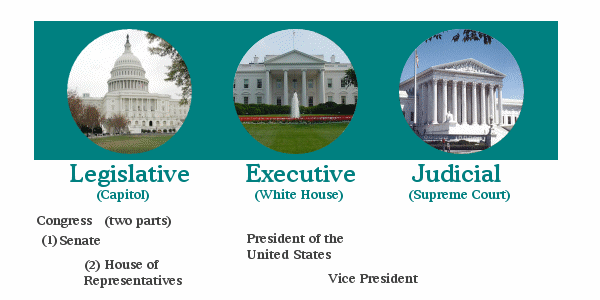Difference between revisions of "Three Branches of Government"
Atekysepiko (Talk | contribs) |
m (Reverted edits by Atekysepiko (Talk); changed back to last version by Admin) |
||
| Line 11: | Line 11: | ||
Congress and the President nominates individuals to serve in the Federal judiciary; the Supreme Court can declare a law enacted by Congress or an action by the President unconstitutional; and Congress can impeach the President and Federal court justices and judges. | Congress and the President nominates individuals to serve in the Federal judiciary; the Supreme Court can declare a law enacted by Congress or an action by the President unconstitutional; and Congress can impeach the President and Federal court justices and judges. | ||
| − | + | == Congress == | |
=== Senate === | === Senate === | ||
| Line 24: | Line 24: | ||
The House is the lower of the two legislative bodies in the U.S. government. | The House is the lower of the two legislative bodies in the U.S. government. | ||
| − | The House of Representatives has the power of impeachment, in which a sitting president, vice president or other civil official such as a judge may be removed for | + | The House of Representatives has the power of impeachment, in which a sitting president, vice president or other civil official such as a judge may be removed for "high crimes and misdemeanors," as enumerated in the Constitution. The House is solely responsible for calling for impeachment. Once it decides to do so, the Senate tries that official to determine whether he or she should be convicted, which means automatic removal from office. |
[[Category:Government]] | [[Category:Government]] | ||
[[Category:Law]] | [[Category:Law]] | ||
| − | |||
| − | |||
| − | |||
| − | |||
| − | |||
| − | |||
| − | |||
| − | |||
| − | |||
Latest revision as of 11:46, 24 November 2010
The three branches of the U.S. Government are the legislative, executive, and judicial.
Article I of the Constitution defines the legislative branch and vests power to legislate in the Congress of the United States.
The executive powers of the President are defined in Article 2.
Article 3 places judicial power in the hands of one Supreme Court and inferior courts as Congress sees necessary to establish
Congress and the President nominates individuals to serve in the Federal judiciary; the Supreme Court can declare a law enacted by Congress or an action by the President unconstitutional; and Congress can impeach the President and Federal court justices and judges.
Congress
Senate
The U.S. Senate is the upper legislative chamber in the federal government. It’s also the more powerful body, with just 100 members. Each state is granted two senators who represent the entire state.
The vice president of the United States presides over the Senate and casts the deciding vote in the event of a tie.
The Senate leadership also includes president pro tempore who presides in the absence of the vice president, a majority leader who appoints members to lead and serve on various committees, and a minority leader.
House of Representatives
The House is the lower of the two legislative bodies in the U.S. government.
The House of Representatives has the power of impeachment, in which a sitting president, vice president or other civil official such as a judge may be removed for "high crimes and misdemeanors," as enumerated in the Constitution. The House is solely responsible for calling for impeachment. Once it decides to do so, the Senate tries that official to determine whether he or she should be convicted, which means automatic removal from office.
